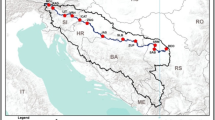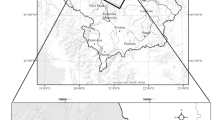Abstract
Rivers in many parts of the world are receptors for all kinds of wastes, including those containing trace metal contaminants. This is particularly so in many African countries where environmental laws are poorly enforced. A common phenomenon in those countries is the overflowing of rivers to the adjacent lands (so-called floodplains), thereby encouraging the cultivation of food crops on the plains, as artificial irrigation is often not necessary. However, toxic trace metals may be deposited when polluted river waters overflow to the plains. Here, we carried out an initial investigation into the impact of flood water deposition on chromium (Cr), cobalt (Co) and lead (Pb) concentrations of three river floodplains in Southwestern Nigeria. Using a sequential extraction technique that fractionates metals in soil into their different species, we show that fluvial deposition contributes more significantly to the lead and cobalt contents of the floodplain soils than the chromium content. Contribution of fluvial deposition to total concentrations of the metals was estimated to be (79.3–99%) for Pb, (67.2–85.7%) for Co, and (37.9–50.4%) for Cr. Clay and organic matter composition of the floodplains were up to 25.6% and 12.8%, respectively, compared to the maximum of 15.9% and 4.7% measured in adjacent non-flooded lands which served as controls. Pb and Cr were detected at values ranging from 0.01 to 0.03 mg/kg in an edible vegetable (Amaranthus hybridus) grown on all the floodplains, thus revealing a route of chronic human exposure to these potentially toxic metals.



Similar content being viewed by others
References
Ademoroti CM (1996) Environmental chemistry and toxicology. Foludex Press Limited, Nigeria
Aiyesanmi AF, Oguntuase AA, Idowu GA (2010) Investigation on speciation and pollution index of heavy metals in river Ala sediment, Akure, Nigeria. Int J Biol Chem Sci 4(6):2348–2359
Aluko T, Njoku K, Adesuyi A, Akinola M (2018) Health risk assessment of heavy metals in soil from the iron mines of Itakpe and Agbaja, Kogi State, Nigeria. Pollution 4(3):527–538
Association of Official Analytical Chemists (AOAC) International (2016) In: Latimer GW Jr (ed) Official methods of analysis, 20th edn. AOAC Inc., Virginia
Bariweni PA, Tarwari CC, Abowei JFN (2012) Some environmental effects of flooding in the Niger Delta region of Nigeria. Int J Fish Aq Sci 1(1):35–46
Brady NC, Weil RR (1999) The nature and properties of soils. Prentice Hall Inc., New Jersey
Crommentuijn T, Polder MD, Van de Plassche EJ (1997) Maximum permissible concentrations and negligible concentrations for metals, taking background concentrations into account. RIVM Report 601501001, Beethoven, The Netherlands
Faleye ET, Olorunfemi MO (2015) Aquifer characterization and groundwater potential assessment of the sedimentary basin of Ondo state. Ife J Sci 17(2):429–439
FAO/WHO Codex Alimentarius Commission (2001) Food additives and contaminants. ALINORM 01(12A):1–289
Gale NL, Adams CD, Wixson BG, Loftin KA, Huang Y (2004) Lead, zinc, copper and cadmium in fish and sediments from the Rig river and Flat river creek of Missouri’s Old Lead Belt. Environ Geochem Health 26:37–49
Gibb H, Chen C (1989) Evaluation of issues relating to the carcinogen risk assessment of chromium. Sci Total Environ 86(1–2):181–186
Grubben GJH (2004) Plant resources of tropical Africa 2. PROTA
Gulson BL, Pounds JG, Mushak P, Thomas BJ, Gray B, Korsch MJ (1999) Estimation of cumulative lead releases (lead flux) from the maternal skeleton during pregnancy and lactation. J Lab Clin Med 134:631–640
Hamelink JL, Landrum PF, Harold BL, William BH (1994) Bioavailability: physical, chemical and biological interactions. CRC Press Inc, Boca Raton
Hendershot WH, Lalande H, Duquette M (1993) Soil reaction and exchangeable acidity. In: Carter MR (ed) Soil sampling and methods of analysis. Canadian Society of Soil Science, Lewis Publishers, London
Iwegbue CMA, Egobueze FEK, Opuene K (2006) Preliminary assessment of heavy metals levels of soils of an oil field in the Niger Delta. Int J Environ Sci Technol 3(2):167–172
Jensen AA, Tüchsen F (1990) Cobalt exposure and cancer risk. Crit Rev Toxicol 20(6):427–437
Klavins M, Briede A, Rodinov V, Kokorite I, Parele E, Klavina I (2000) Heavy metals in rivers of Latvia. Sci Total Environ 262:175–183
Kolawole OM, Ajayi T, Olayemi AB, Okoh AI (2011) Assessment of water quality in Asa river (Nigeria) and its indigenous Clarias gariepinus. Int J Environ Res Public Health 8:4332–4352
Laffite A, Kilunga PI, Kayembe JM, Devarajan N, Mulaji CK, Giuliani G, Slaveykova VI, Poté J (2016) Hospital effluents are one of several sources of metal, antibiotic resistance genes, and bacterial markers disseminated in Sub-Saharan urban rivers. Front Microbiol 7:1128. https://doi.org/10.3389/fmicb.2016.01128
Landrigan PJ, Sonawane B, Butler RN, Trasande L, Callan R, Droller D (2005) Early environmental origins of neurodegenerative disease in later life. Environ Health Perspect 113:1230–1233
Léonard A, Lauwerys R (1990) Mutagenicity, carcinogenicity and teratogenicity of cobalt metal and cobalt compounds. Mutat Res Genet Toxicol 239(1):17–27
Maiz I, Arambarri I, Garcia R, Millan E (2000) Evaluation of heavy metal availability in polluted soils by two sequential extraction procedures using factor analysis. J Environ Qual 6:604–610
Mokwunye IU, Babalola FD, Ndagi I, Idrisu M, Mokwunye FC, Asogwa EU (2012) Farmers’ compliance with the use of approved cocoa pesticides in cocoa producing states of Nigeria. J Agric Soc Res 12(2):44–60
Morita M (2011) Quantification of increased flood risk due to global climate change for urban river management planning. Wat Sci Tech 63(12):2967–2974
Ogwuegbu MOC, Muhanga W (2005) Investigation of lead concentration in the blood of people in the Copperbelt Province of Zambia. J Environ 1:66–75
Omole DO, Isiorho S (2011) Waste management and water quality issues in coastal states of Nigeria: the Ogun State experience. J Sustain Dev Afr 13(6):207–217
Owusu-Sekyere E, Bagah DA, Dwamena Quansah JY (2015) The urban solid waste management conundrum in Ghana: will it ever end? World Environ 5(2):52–62. https://doi.org/10.5923/j.env.20150502.02
Paiva LB, de Oliveira JG, Azevedo RA, Ribeiro DR, da Silva MG, Vit´oria AP (2009) Ecophysiological responses of water hyacinth exposed to Cr3+ and Cr6+. Environ Exp Bot 65(2–3):403–409
Peralta-Videa JR, Lopez ML, Narayan M, Saupe G, Gardea-Torresdey J (2009) The biochemistry of environmental heavy metal uptake by plants: implications for the food chain. Int J Biochem Cell Biol 41(8–9):1665–1677
Prekeyi TF, Megbuwe P, Adams OG (2015) Some aspects of a historic flooding in Nigeria and its effects on some Niger-Delta communities. Am J Water Resour 3(1):7–16
Ratuzny T, Gong Z, Wilkes BM (2009) Total concentration and speciation of heavy metals in soil of Shenyang Zhanshi irrigation area, China. Environ Monit Assess 156(1–4):171–180
Rowbotham AL, Levy LS, Shuker LKJ (2000) Chromium in the environment: an evaluation of exposure of the UK general population and possible adverse health effects. Toxicol Environ Health B Crit Rev 3(3):145–178
Salaudeen IA, Ogunbamowo P, Rasheed-Adeleke AA, Olaniyi AA (2018) Assessment of heavy metals and microbial load of groundwater samples from Ibadan metropolis Nigeria. Pollution 4(3):429–438
Schulte EE (1995) Recommended soil organic matter tests. In: Sim JT, Wolf AM (eds) Recommended soil test procedure for the North Eastern USA. Northern Regional Publication No 493, Agricultural experiment station, University of Delaware, Newark
Seymour T (2013) Foraging new England. Falcon guides, 2nd edn. Morris Book Publishing, LLC, Bordentown
Shanbehzadeh S, Dastjerdi MV, Hassanzadeh A, Kiyanizadeh T (2014) Heavy metals in water and sediment: a case Study of Tembi river. J Environ Public Health. https://doi.org/10.1155/2014/858720 (Article ID 858720)
Shedrick BH, Wang C (1993) Particle size distribution. In: Carter MR (ed) Soil sampling and methods of analysis. Canadian Society of Soil Science, Lewis Publishers, London
Silbergeld EK (2003) Facilitative mechanisms of lead as a carcinogen. Mutat Res 533(1–2):121–133
Silbergeld EK, Waalkes M, Rice JM (2000) Lead as a carcinogen: experimental evidence and mechanisms of action. Am J Ind Med 38(3):316–323
Singh KP, Malik A, Sinha S, Singh VK, Murthy RC (2005) Estimation of source of heavy metal contamination in sediments of Gomti river (India) using principal component analysis. Water Air Soil Pollut 166:321–341
Suh M, Thompson CM, Brorby GP, Mittal L, Deborah M (2016) Inhalation cancer risk assessment of cobalt metal. Regul Toxicol Pharmacol 79:74–82
Tessier A, Campbell PGC (1987) Partitioning of trace metals in sediments: relationships with bioavailability. Hydrobiologia 149(1):43–52
Tessier A, Campbell PGC, Bisson M (1979) Sequential extraction procedure for the speciation of particulate trace metals. Anal Chem 51:844–851
Udoh BT, Ogunkunle AO, Ndaeyo NU (2007) Influence of soil series and physico-chemical properties on weed flora distribution at Moore plantation Ibadan, Southwestern Nigeria. Int J Agric Crop Sci 3:91–99
Uduma AU, Jimoh WLO (2013) Sequential extraction procedure for partitioning of lead, copper, cadmium, chromium and zinc in contaminated arable soils of Nigeria. Am J Environ Energy Power Res 1(9):186–208
Usikalu MR, Achuka JA (2014) Physiochemical parameters and trace elements of soil samples collected from Ogun State, Nigeria. Aust J Basic Appl Sci 8(17):137–141
Wang Y, Su H, Gu Y, Song X, Zhao J (2017) Carcinogenicity of chromium and chemoprevention: a brief update. Onco Targets Ther 10:4065–4079
Yi Y, Yang Z, Zhang S (2011) Ecological risk assessment of heavy metals in sediment and human health risk assessment of heavy metals in fishes in the middle and lower reaches of the Yangtze river basin. Environ Pollut 159:2575–2585
Acknowledgements
We thank Technologists in the Central Research Laboratories and those in the Chemistry department, Federal University of Technology, Akure, for their technical support, both on the field and in the laboratories.
Author information
Authors and Affiliations
Corresponding author
Ethics declarations
Conflict of interest
The authors declare that they have no conflict of interest.
Additional information
Publisher's Note
Springer Nature remains neutral with regard to jurisdictional claims in published maps and institutional affiliations.
Electronic supplementary material
Below is the link to the electronic supplementary material.
Rights and permissions
About this article
Cite this article
Maduawuchi, C.O., Idowu, G.A. & Aiyesanmi, A.F. Impact of fluvial deposition on potential toxic metals burden of selected floodplains in Southwestern Nigeria. Environ Earth Sci 78, 561 (2019). https://doi.org/10.1007/s12665-019-8574-8
Received:
Accepted:
Published:
DOI: https://doi.org/10.1007/s12665-019-8574-8




